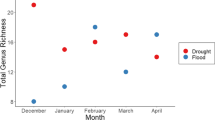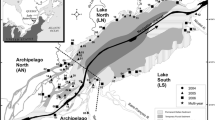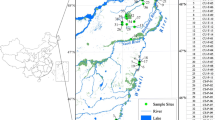Abstract
Wetlands provide critical wildlife habitat in the central Platte River basin of Nebraska, USA, but little is known about their macroinvertebrate communities or how factors such as hydrology affect them. In 1997, we quantified macroinvertebrate abundance, biomass, and community structure and organic matter resources in four natural wetlands that represented a gradient from ephemeral to permanent flooding. All four wetlands had abundant macroinvertebrate communities when flooded, and we observed unique taxa at all sites. Mean annual macroinvertebrate abundance and biomass increased with hydroperiod length, but taxon richness and diversity were greatest in intermittent sites. Non-insect groups, mostly crustaceans, annelids, and mollusks, were important at all sites, and their taxonomic composition shifted across the hydrologic gradient. Insect communities were dominated by dipterans (mostly Chironomidae and Ceratopogonidae) and Coleopterans (mostly Hydrophilidae and Dytiscidae), and these also varied across the hydrologic gradient. Collector-gatherers, scrapers, and predators were the dominant functional groups in terms of biomass, and biomass was most evenly distributed among these groups in intermittent sites. Macroinvertebrate communities in these riparian wetlands vary across natural hydrologic gradients, and diversity peaks in intermittent sites. Patterns of abundance, biomass, and diversity, along with seasonal patterns, suggest that, at a landscape level, a diversity of wetland habitats with different hydrologic regimes will maximize abundance and diversity of freshwater macroinvertebrate communities in this region.
Similar content being viewed by others
Literature cited
Batzer, D. P., R. B. Rader, and S. A. Wissinger. 1999. Invertebrates in freshwater wetlands of North America: ecology and management. John Wiley & Sons, New York, NY, USA.
Batzer, D. P. and S. A. Wissinger. 1996. Ecology of insect communities in nontidal wetlands. Annual Review of Entomology 41:75–100.
Benke, A. C., A. D. Huryn, L. A. Smock, and J. B. Wallace. 1999. Length-mass relationships for freshwater macroinvertebrates in North America with particular reference to the southeastern United States. Journal of the North American Benthological Society 18:308–343.
Bottrell, H. H., A. Duncan, Z. M. Gliwicz, E. Grygierek, A. Herzig, A. Hillbricht-Ilkowska, H. Kurasawa, P. Larsson, and T. Weglenska. 1976. A review of some problems in zooplankton production studies. Norwegian Journal of Zoology 24:419–456.
Corti, D., S. L. Kohler, and R. E. Sparks. 1997. Effects of hydroperiod and predation on a Mississippi River floodplain invertebrate community. Oecologia 109:154–165.
Cowardin, L. M., V. Carter, F. C. Golet, and E. T. LaRoe. 1979. Classification of wetlands and deepwater habitats of the United States. U. S. Fish and Wildlife Service, Washington, DC, USA. FWS/OBS-79/31.
Dodds, W. K., K. B. Gido, M. R. Whiles, K. M. Fritz, and W. J. Matthews. 2004. Life on the edge: the ecology of Great Plains prairie streams. Bioscience 54:205–216.
Ervin, G. N. and R. G. Wetzel. 2002. Influence of a dominant macrophyte,Juncus efffusus, on wetland plant species richness, diversity, and community composition. Oecologia 130:626–636.
Euliss, N. H., Jr., D. A. Wrubleski, and D. M. Mushet. 1999. Wetlands of the prairie pothole region: invertebrate species composition, ecology, and management. p. 471–514.In D. P. Batzer, R. B. Rader, and S. A. Wissinger (eds.) Invertebrates in Freshwater Wetlands of North America, Ecology and Management. John Wiley and Sons, New York, NY, USA.
Goldwitz, B. S., and M. R. Whiles. 1999. Investigations of fish, amphibians, and aquatic invertebrate species within the middle Platte River system. Final Report, Platte Watershed Program Cooperative Agreement X99708101. USEPA Region VII, Kansas City, MO, USA.
Hall, D. L., R. W. Sites, E. B. Fish, T. R. Molhagen, D. L. Moorhead, and M. R. Willig. 1999. Playas of the southern High Plains: the macroinvertebrate fauna. p. 635–666.In D. P. Batzer, R. B. Rader, and S. A. Wissinger (eds.) Invertebrates in Freshwater Wetlands of North America, Ecology and Management. John Wiley and Sons, New York, USA.
Huener, J. D. and J. A. Kadlec. 1992. Macroinvertebrate response to marsh management strategies in Utah. Wetlands 12:72–78.
Hurlbert, S. H. 1984. Pseudoreplication and the design of ecological field experiments. Ecological Monographs 54:187–211.
Hurlbert, S. H. and M. D. White. 1993. Experiments with freshwater invertebrate zooplanktivores: quality of statistical analyses. Bulletin of Marine Science 53:128–153.
Jenkins, D. G., S. Grissom, and K. Miller. 2003. Consequences of prairie wetland drainage for crustacean biodiversity and metapopulations. Conservation Biology 17:158–167.
Kohler, S. L., D. Corti, M. C. Slamecka, and D. W. Schneider. 1999. Prairie floodplain ponds: mechanisms affecting invertebrate community structure. p. 711–732.In D. P. Batzer, R. B. Rader, and S. A. Wissinger, (eds.) Invertebrates in Freshwater Wetlands of North America: Ecology and Management. John Wiley & Sons, New York, NY, USA.
Lovvorn, J. R., W. M. Wolheim, and A. H. Hart. 1999. High plains wetlands of southeast Wyoming: salinity, vegetation, and invertebrate communities. p. 603–634.In D. P. Batzer, R. B. Rader, and S. A. Wissinger (eds.) Invertebrates in Freshwater Wetlands of North America, Ecology and Management. John Wiley and Sons, New York, NY, USA.
Mallory, M. L., P. J. Blancher, P. J. Weatherhead, and D. K. McNicol. 1994. Presence or absence of fish as a cue to macroinvertebrate abundance in boreal wetlands. Hydrobiologia 279–280:345–351.
Matthews, W. J. 1988. North American prairie streams as systems for ecological study. Journal of the North American Benthological Society 7:387–409.
Merrit R. W. and K. W. Cummins (eds.). 1996. An Introduction to the Aquatic Insects of North America, 3rd ed. Kendall-Hunt Publishing, Dubuque, IA, USA.
Poff, N. L. and J. D. Allan. 1995. functional organization of stream fish assemblages in relation to hydrologic variability. Ecology 76:606–627.
Pollock, M. M., R. J. Naiman, and T. A. Hanley. 1998. Plant species richness in riparian wetlands-a test of biodiversity theory. Ecology 79:94–105.
Reinecke, K. J. and G. L. Krapu. 1986. Feeding ecology of sandhill cranes during spring migration in Nebraska. Journal of Wildlife Management 50:71–79.
Resh, V. H., A. B. Brown, A. P. Covich, M. E. Gurtz, H. W. Li, G. W. Minshall, S. R. Reice, A. L. Sheldon, J. B. Wallace, and R. C. Wissmar. 1988. The role of disturbance in stream ecology. Journal of the North American Benthological Society 7:433–455.
Sidle, J. G., E. D. Miller, and P. J. Currier. 1989. Changing habitats in the Platte River valley of Nebraska. Prairie Naturalist 21:91–104.
Smith, D. G. 2001. Pennak's Freshwater Invertebrates of the United States, Porifera to Crustacea. 4th ed. John Wiley and Sons, New York, NY, USA.
Snodgrass, J. W., M. J. Komoroski, A. L. Bryan, jr., and J. Burger. 2000. Relationships among isolated wetland size, hydroperiod, and amphibian species richness: implications for wetland regulations. Conservation Biology 14:414–419.
Stanley, E. H. and S. G. Fisher. 1992. Intermittency, disturbance, and stability in stream ecosystems. p. 271–280.In R. D. Robarts and M. L. Bothwell (eds.) Aquatic Ecosystems in Semi-Arid Regions: Implications for Resource Management. Environment Canada, Saskatoon, Saskatchewan, Canada.
Thorp, J. H. and A. P. Covich. 1991. Ecology and Classification of North American Freshwater Invertebrates. Academic Press, New York, NY, USA.
U.S. Fish and Wildlife Service. 1997. Biological opinion on the Federal Energy Regulatory Commission's preferred alternative for the Kingsley dam project and North Platte/Keystone dam project. U.S. Fish and Wildlife Service, Grand Island, NE, USA.
van der Valk, A. G. 1981. Succession in wetlands: a Gleasonian approach. Ecology 62:688–696.
Vileisis, A. 1997. Discovering the Unknown Landscape: a History of America's Wetlands. Island Press, Washington, DC, USA.
Wallen, B., U. Falkengren-Grerup, and N. Malmer. 1988. Biomass, productivity and relative rate of photosynthesis of sphagnum at different water levels on a South Swedish peat bog. Holarctic Ecology 11:70–76.
Wellborn, G. A., D. K. Skelly, and E. E. Werner. 1996. Mechanisms creating community structure across a freshwater habitat gradient. Annual Review of Ecology and Systematics 27:337–363.
Wesche, T. A., Q. D. Skinner, and R. J. Henszey. 1994. Platte River wetland hydrology study: final report. Wyoming Water Resources Center, Laramie, WY, USA.
Whiles, M. R. and B. S. Goldowitz. 1998. Biological response to hydrologic fluctuation in wetland sloughs of the central Platte River. p. 3–18.In G. Lingle (ed.) Proceedings of the Ninth Platte River Ecosystem Symposium. University of Nebraska Cooperative Extension-Platte Watershed Program, Kearney, NE, USA.
Whiles, M. R. and B. S. Goldowitz. 2001. Hydrologic influences on insect emergence production from central Platte River wetlands. Ecological Applications 11:1829–1842.
Whiles, M. R., B. S. Goldowitz, and R. E. Charlton. 1999. Life history and production of a semi-terrestrial limnephilid caddisfly in an intermittent Platte River wetland. Journal of the North American Benthological Society 18:533–544.
Wissinger, S. A. 1999. Ecology of wetland invertebrates: synthesis and applications for conservation and management. p. 1043–1086.In D. Batzer, R. B. Rader, and S. A. Wissinger (eds.) Invertebrates in Freshwater Wetlands of North America: Ecology and Management. John Wiley and Sons, New York, NY, USA.
Wissinger, S. A., W. S. Brown, and J. E. Jannot. 2003. Caddisfly life histories along permanence gradients in high- altitude wetlands in Colorado (USA). Freshwater Biology 48:255–270.
Wissinger, S. A., H. H. Whiteman, G. B. Sparks, G. L. Rouse, and W. S. Brown. 1999. Foraging trade-offs along a predator-permanence gradient in subalpine wetlands. Ecology 80:2102–2116.
Zimmer, K. D., M. A. Hanson, and M. G. Butler. 2000. Factors influencing invertebrate communities in prairie wetlands: a multivariate approach. Canadian Journal of Fisheries and Aquatic Sciences 57:76–85.
Zimmer, K. D., M. A. Hanson, M. G. Butler, and W. G. Duffy. 2001. Size distribution of aquatic invertebrates in two prairie wetlands, with and without fish, with implications for community production. Freshwater Biology 46:1373–1386.
Author information
Authors and Affiliations
Rights and permissions
About this article
Cite this article
Whiles, M.R., Goldowitz, B.S. Macroinvertebrate communities in central Platte River wetlands: Patterns across a hydrologic gradient. Wetlands 25, 462–472 (2005). https://doi.org/10.1672/20
Received:
Revised:
Accepted:
Issue Date:
DOI: https://doi.org/10.1672/20




